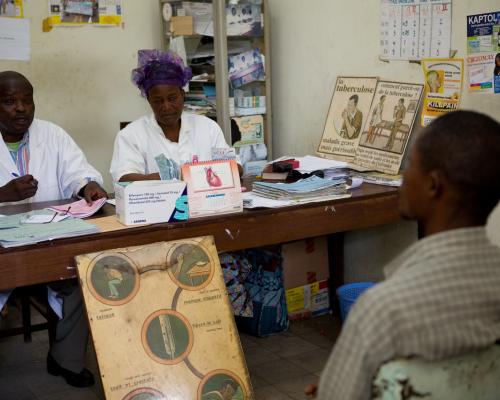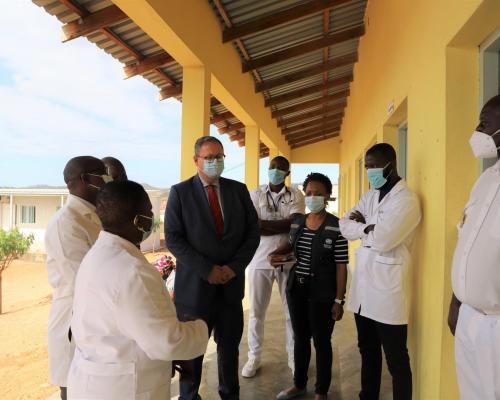Remarks by WHO Regional Director for Africa, Dr Matshidiso Moeti
Good day, bonjour and welcome to all the journalists who are joining us for this press conference.
Today we will focus on the ongoing efforts to boost COVID-19 vaccine coverage and uptake in African countries, alongside the response to multiple other outbreaks that are challenging the continent’s health responders.
I am really pleased to be joined today by the Honourable Minister of Health of Liberia, Dr Wilhelmina Jallah, whose country recently became the third African country to achieve 70% primary COVID-19 vaccine coverage of its population. A huge congratulations to you and your country, Minister, and a warm welcome.
I’m also honoured to be joined by Ms Aurelia Nguyen, Special Adviser to GAVI, the Vaccine Alliance. Ms Nguyen was instrumental in setting up the COVAX Facility, through which 580 million or so COVID-19 vaccine doses have been provided to 53 African countries by international partners, and many lessons learned about global solidarity at the same time. A very warm welcome, Ms Nguyen.
Newly returned from the 2022 World Health Summit in Berlin, I was gratified to see the high priority the global health community is affording the critical issues of pandemic preparedness, and of resuming progress towards Universal Health Coverage.
The significant health advances being made by African countries deserve merit. However, with 11 serious disease outbreaks currently being addressed in 47 Member States, and I think about 120 other less serious ones being addressed as well, alongside reduced COVID-19 vigilance, there is serious cause for concern, and need for additional effort.
The COVID-19 vaccine rollout is unfortunately stagnating. The monthly total number of doses being delivered into the arms of African people dropped by more than half between July and September.
It is positive that we are making modest progress towards vaccinating high-risk population groups. Currently, one in every three people aged over 50 has completed the primary series, together with 40% of health care workers.
But when overall African vaccination rates are nearly two-thirds lower than the global average, it’s clear there is still much work to be done.
Critically, high vaccination coverage in populations reduces the spread of the virus, and helps prevent new variants from emerging.
Liberia has now reached the 70% coverage target, along with Mauritius and Seychelles, so we know that success, and progress, are possible. Rwanda is on target to join them very soon.
We’ve also seen a significant decrease in the number of countries in which fewer than 10% of people have completed the primary series, from 26 at the end of last year, to only five now.
It’s important to note that vaccine supply is no longer problematic; countries are now receiving about double the number of doses per 100 people than at the end of last year.
I’d like to sincerely thank the COVAX partnership for turning around a tragically inequitable situation and, together with the African Union’s African Vaccine Acquisition Trust (AVAT), assuring this steady pipeline.
Unfortunately, as vaccines have helped avert serious COVID-19 illness, hospitalisation and death, people are less fearful, and so also less willing to get vaccinated. Delivery strategies and systems are also being adjusted and strengthened.
WHO in Africa has embarked on a raft of measures to support Member States. These include assisting countries to integrate COVID-19 vaccines into other planned mass vaccination campaigns, to track vaccination among priority groups, and to carry out high-level advocacy to boost the uptake.
Meanwhile, other disease outbreaks, to which I referred earlier, are also prompting a shift in priorities in affected countries, negatively impacting efforts to ramp up COVID-19 vaccination rates.
Today marks one month since the latest Ebola outbreak in Uganda was declared.
With 64 confirmed cases, three of whom travelled to the capital Kampala, and 25 confirmed deaths, the situation on the ground is rapidly evolving.
The Ministry of Health of Uganda has shown remarkable resilience and effectiveness in constantly fine-tuning the response to what is a challenging situation. The health authorities have rapidly strengthened surveillance, identifying nearly 2000 contacts.
A better understanding of the chains of transmission is helping those on the ground respond more effectively.
WHO, the Africa Centres for Disease Control (ACDC), and other partners are marshalling response capacities across the Region, to support Uganda and six neighbouring countries.
A US$ 100-million, six-month regional readiness and response plan is being finalised, with an alert management system now fully activated in Kampala for better case detection.
As WHO, we’ve disbursed US$5 million for the response from our Contingency Fund for Emergencies (CFE), and are providing technical and operational support, while helping with the national coordination of partners.
We’ve deployed 43 technical officers to support the response at national and district level, along with 15 tons of personal protective equipment, 17 vehicles, and various Infection Prevention and Control (IPC) supplies for managing cases. We’ve also sent Ebola kits to set up emergency temporary hospitals.
As always, community engagement is critical to build trust, cooperation and understanding.
Turning now to polio, it was extremely encouraging to see global leaders this week confirm US$ 2.6 billion in funding towards the Global Polio Eradication Initiative’s (GPEI) 2022-26 strategy to end the threat – more than half the US$4.6-billion target.
Ahead of World Polio Day on Monday, let me stress that this global solidarity and top-level political commitment is essential to finally eradicating both wild polio virus Type 1, and Variant type 2 poliovirus.
A total 500 million doses of vaccine against variant Type 2 poliovirus have been delivered globally, with 21 African countries administering 95% of these and among these countries, 80% have seen no further transmission of the virus after two immunisation rounds.
So, together with the polio partners, we are also closely monitoring vaccination rounds targeting about 7.5 million children in Malawi and Mozambique, to ensure that no child is left behind. Vaccination campaigns are continuing in Tanzania, Zambia and Zimbabwe.
We are also setting up an Emergency Operations Centre in Mozambique, which will provide a central location from which to coordinate data collection, and the response to what is another serious public health threat.
Going forward, we are working to maintain the response to COVID-19 and these other outbreaks, while also supporting the resumption of routine health services that have been disrupted by the pandemic.
So again, thank you very much for having joined us today. A very warm welcome to my fellow panelists, and I look forward to our conversation.


